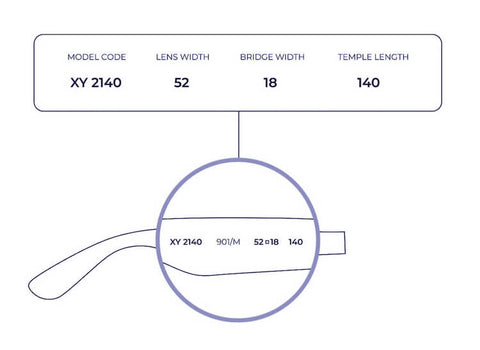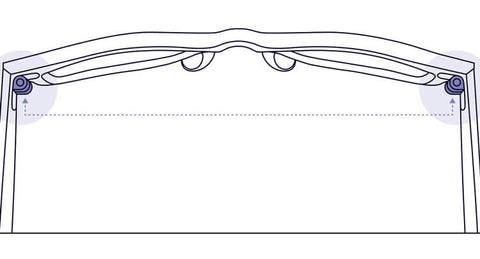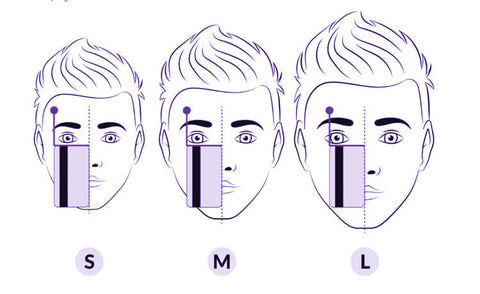Computer glasses and blue light glasses are designed for different purpose but actually solve similar problem and the problem is eye strain.
After the revolution of the digital world screen time has constantly increased from computer to laptop to mobile for that reason humans require extra eye protection that can protect the eye from blue light UV rays that comes from digital screens.
At the current time, there are two types of glasses comes one is computer glasses and second is blue light gaming glasses.
In this blog post, we'll delve into the differences between these two types of glasses and help you understand which one might be right for you.
What are Computer Glasses?
Computer glasses, also known as computer vision glasses, are designed specifically for individuals who spend a significant amount of time in front of digital screens like computers, laptops, tablets, and mobile phones
These glasses come with specialized lenses that help reduce eye strain and fatigue caused by prolonged screen use and protect from bad UVs that come from the screen.

A lenses typically have an anti-reflective coating that minimizes glare and helps improve contrast and clarity.
Key features of computer glasses:
- Customized lens prescriptions for optimal vision at a specific viewing distance (usually around 20-26 inches)
- Anti-reflective coatings to reduce glare
- Tinted lenses to enhance contrast and reduce eye strain
Frame types for computer glasses:
·Rimless Frames Rimless computer glasses have a minimalist, lightweight design with the lenses directly attached to the temples without a frame rim. This style creates an unobstructed field of vision and tends to be very comfortable for extended wear.
·Semi-Rimless Frames Semi-rimless frames have a partial rim that secures the bottom portion of the lenses, while the top is rimless. This hybrid design offers a balance of style and durability while still providing a wide field of view.
·Full-Rim Frames Traditional full-rim frames surround and secure the lenses. It has a Square frames, round frames and cat eye frames glass option available. Full-rim computer glasses come in a variety of materials like plastic, metal, or combinations.
·Wraparound Frames Wraparound styles curve around the face and temples to protect eyes from light entering from the sides. They have a closer, more secure fit and are popular for both computer use and outdoor activities.
·Browline Frames Browline or semi-rimless computer glasses have a thicker top frame section that sits on the browline with an open-air bottom. This retro style can be both stylish and functional.
·Each frame type has pros and cons in terms of fit, vision, durability, and appearance. An optician can make recommendations based on an individual's face shape, vision needs, and personal preferences for computer glasses.
Price range for computer glasses:
In the USA and around the world computer glasses prices are based on frame material and lens selection there are Plastic material frames, titanium frames, and more materials of frame available.
|
Category |
Price Range |
|
Budget Computer Glasses |
$30 - $80 |
|
Mid-Range Computer Glasses |
$100 - $250 |
|
Premium/Designer Computer Glasses |
$300 - $600+ |
|
Custom Computer Glasses |
$500+ |
What are the benefits of wearing computer glasses while using?
Wearing computer glasses or blue light-blocking glasses while using digital devices like computers, tablets, and smartphones can provide several benefits:
1. Reduced eye strain and fatigue: The blue light from screens can make your eyes work harder to focus, leading to tired, dry, and irritated eyes after long use. Computer glasses filter out some of this blue light.
2. Better sleep: Blue light exposure at night can disrupt your body's sleep cycle by suppressing melatonin production. Wearing blue light-blocking glasses a few hours before bed may improve sleep quality.
3. Fewer headaches: Eye strain from prolonged screen time can trigger headaches and migraines for some people. The reduced blue light from computer glasses may provide relief.
4. Improved contrast and clarity: Anti-reflective coatings on computer glasses can enhance contrast on screens and minimize glare, increasing visual comfort during extended computer use.
5. UV protection: Many computer glasses also protect your eyes from the UV rays emitted by digital devices, preventing long-term exposure damage.
While more research is ongoing, many users report reduced visual discomfort and increased productivity when wearing properly prescribed computer glasses during extended digital device usage.
What are Blue Light Glasses?
Blue light glasses are designed to filter out or block a portion of the blue light emitted by computer screens and are best for gamers who are spending around more than 8 hours in front of the screen.
Blue light is part of the visible light spectrum and has a shorter wavelength than other colors. While some exposure to blue light is beneficial during the day, excessive exposure can disrupt our natural sleep-wake cycle and contribute to eye strain and headaches.
Key features of blue light glasses:
- Lenses that block or filter out a specific range of blue light wavelengths
- Available in different tints (amber, yellow, or clear with a blue light filter coating)
- Can be worn indoors and outdoors for protection against blue light
Frame types for blue light glasses:
- Plastic frames in various colors and styles
- Lightweight metal frames for a more modern look
- Stylish and trendy designs to suit different personal preferences
Here's a concise and easy-to-understand overview of the different frame materials used for blue light glasses:
1. Titanium: Extremely lightweight yet incredibly durable metal. Hypoallergenic and can be colored. Provides a sleek, modern look.
2. TR (Thermoplastic Rubber): Flexible and lightweight material used for components like temples and nose pads. Ensures a comfortable, slip-resistant fit.
3. Acetate: Premium, plant-based material known for rich colors and unique patterns. Lightweight yet durable, with a luxurious appearance.
4. Metal (stainless steel, aluminum): Durable and maintains shape well. Often features minimalist, clean-lined designs for a modern aesthetic. Available in full-rim or semi-rimless styles.
5. Plastic (zylonite, acetate, propionate): Affordable and lightweight option. Vast color and style choices, from bold to classic. Can be molded into trendy shapes like cat-eye or round.
When choosing your blue light glasses, consider factors like durability, weight, aesthetics, and any skin sensitivities to find the perfect frame material that protects your eyes while matching your personal style and needs.
|
Category |
Price Range |
|
Budget Blue Light Glasses |
$10 - $30 |
|
Mid-Range Blue Light Glasses |
$30 - $80 |
|
Premium Blue Light Glasses |
$80 - $200+ |
But in general, basic blue light glasses start around $10-30, while premium options with advanced lenses and designer frames can range from $100 to over $200.
Choosing the Right Glasses: When deciding between computer glasses and blue light glasses, consider your specific needs and usage patterns:
- If you spend most of your time working on a computer or digital device at a fixed distance, computer glasses may be the better choice. They are optimized for that viewing distance and can provide superior visual clarity and comfort.
- If you frequently use multiple digital devices (computer, smartphone, tablet) at varying distances or spend a lot of time exposed to artificial blue light, blue light glasses may be a more versatile option. They can help reduce eye strain and promote better sleep quality.
- Some people may benefit from wearing both types of glasses depending on their activities. Computer glasses can be worn during extended computer use, while blue light glasses can be worn for general digital device usage and outdoor activities.
It's important to note that both computer glasses and blue light glasses are available with or without prescription lenses, so they can be tailored to your specific vision needs.
Advantages of Blue Light Glasses:
- Reduce eye strain, fatigue, and headaches from digital screens
- May improve sleep quality by limiting blue light exposure at night
- Can increase contrast and clarity on screens with anti-reflective coatings
- Provide protection against potential blue light damage to eyes
- Help alleviate digital eye strain-related migraines
Disadvantages of Blue Light Glasses:
- Effectiveness in reducing eye issues and preventing damage is still being researched
- May cause slight color distortion on digital screens
- Eyes need time to adapt to the blue light filtering
- High-quality options can be expensive
- Not ideal for outdoor daytime use due to light/color distortion





























